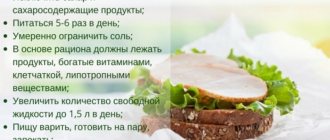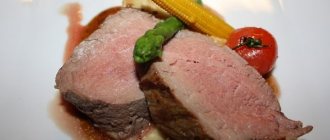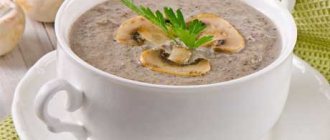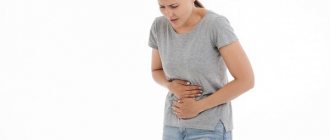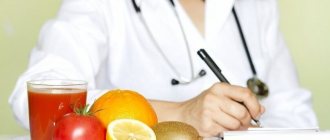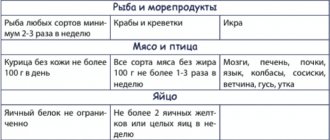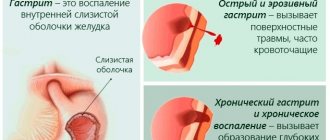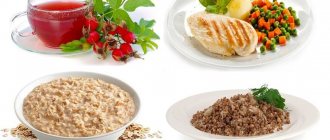Reflux esophagitis is an inflammation of the epithelium of the esophageal tube, resulting from the reflux of stomach contents into the lower part of the esophagus.
A diet for reflux esophagitis limits foods that irritate the epithelium of the esophagus, and also limits the amount of food consumed. To achieve the maximum effect in treatment, you need to combine dietary nutrition with medication treatment, as well as normalize your work and rest schedule. Let's figure out what you can eat if you have reflux esophagitis.
Diet for gastroesophageal reflux disease: menu
Often, when treating diseases of the digestive system, it is not even the food that a person eats that matters, but the basics of its proper preparation or some features in the behavior of the person himself before or after a meal. How not to harm the body when treating GERD?
- The diet should be varied, you need to eat often and in small portions, at least 5-6 times a day.
- Don't overeat. The principles of psychology help here: take a plate 2 times smaller than usual, the dishes should be neutral and cold tones, so as not to further stimulate the appetite. Add less salt and spices to your dishes.
- During the period of intensive treatment, it is important to avoid aggressive foods. Here, first of all, you need to exclude fried and smoked foods. Such food negatively affects the damaged mucous membrane of the esophagus and stomach, irritating it and contributing to the exacerbation of the disease.
- There should be no juiced foods: raw onions and garlic, hot red peppers and other potent spices will have to be eliminated from the diet for a long time; store-bought juices should not be consumed either.
- Another important rule is that the last meal should be at least 2 hours before bedtime. You should not eat at night, and under no circumstances go to bed immediately after eating!
- You need to eat food in a calm environment, chewing thoroughly. Any physical activity after eating will have to be postponed for at least 1 hour so as not to provoke the backflow of food into the esophagus from the stomach.
- Remember! Diet for GERD can vary depending on a person's individual preferences.
- During the period of remission (when the exacerbation has passed and the person’s well-being has improved significantly), the list of products expands, but the general principles remain unchanged.
- You cannot go hungry - this is a direct path to the resumption of heartburn and unbearable chest pain.
And now, let’s take a closer look at this and much more in the treatment of gastroesophageal reflux disease with the help of diet.
Once diagnosed, patients with reflux esophagitis should follow these helpful tips to relieve the main symptoms of the disease.
- Before meals, it is recommended to drink 0.2 liters of cold boiling water to reduce the production of gastric secretions.
- Potato juice or eating pieces of raw root vegetables will help relieve heartburn for several hours.
- Before your meal, you can eat a piece of fresh wheat bread or a handful of hazelnuts: these foods will reduce acid production.
- Alcohol drunk on an empty stomach causes harm to the stomach and esophagus comparable to eating 0.5 kg of spicy and fatty potato chips.
- Evening snacks before bed are bad not only for your figure, but also for your stomach: heavy food does not have time to be digested before going to bed and rots in the stomach and intestines all night.
- You can’t eat anything 2 hours before going to bed: it will cause heartburn. It is allowed to drink green tea without sugar, chamomile decoction and plain water.
- After a meal, you should never take a horizontal position: this makes it easier for the contents of the stomach to spill into the esophagus and provoke another attack of heartburn.
- It is not recommended to wear tight belts around the waist, shapewear, or clothes that restrict movement. Tight pants are a common cause of gastric juice reflux into the esophagus.
- You need to eat very often (7 times a day), at short intervals. The portion should fit into the palm of your hand or a small saucer.
- Meals must be washed down with tea or water.
- Low-fat fermented milk products should become the basis of nutrition for a patient with reflux esophagitis.
- A sweet fruit (banana or pear), eaten on an empty stomach, will help quickly and permanently get rid of heartburn.
1. Medications:
- proton pump inhibitors or blockers that reduce gastric acidity (Pantoprazole, Nexium, Omez, Nolpaza);
- antacid drugs (Rutacid, Maalox, Gaviscon, Rennie, Almagel);
- gastroprotectors (“De-nol”, “Bismofalk”, “Venter”);
- sedatives.
2. Non-drug treatment:
- normalization of diet;
- diet for GERD;
- folk remedies.
3. Surgical treatment (as a last resort).
1. It is necessary to diversify your diet and eat 5-6 times a day.
2. Reduce the usual portion by half. Don't get carried away with spices and salt.
3. During an exacerbation, exclude baked and fried foods. Eat light foods that do not injure the sore stomach and do not cause accelerated production of gastric juice. Two concepts for GERD must be firmly connected: treatment - diet.
4. Don't overeat at night! The minimum interval between bedtime and dinner is 2 hours.
5. Chew your food thoroughly!
6. After eating, you should not exercise or do physical work.
7. During the period of remission, try to adhere to the basic rules.
https://youtu.be/5ZjU07km8Qw
8. Never starve!
9. The diet is selected based on the individual characteristics and preferences of the patient.
Broth with egg flakes
Make broth from lean meat (poultry, beef, veal). Beat two eggs and pour them into 1 liter of boiling meat broth, mix thoroughly and add salt. You can add diced white bread croutons.
Meatballs
Grind 1 kg of veal or chicken meat in a meat grinder. Add 100 g of white bread soaked in milk or water and 1 egg. Place in lightly salted water, wait until it boils, reduce heat and cook for 10 minutes.
Zucchini and potato puree
Cut 1 zucchini and 3-4 medium-sized potatoes into slices, boil, puree using a masher or blender, add 10-20 g of butter.
Omelette with cauliflower
Boil 1 head of cauliflower, cut into florets, in salted water. Grease a baking dish with oil and place the cabbage in the pan. Beat 2 eggs, add 100-150 g of milk, beat again and pour over the cabbage. Steam.
Meat pate
Boil 1 kg of chicken, beef or veal. Can be combined. In 20 min. Before the end of cooking, throw the boiled carrots into the pan. Cut the meat into pieces, grind in a meat grinder or blender along with carrots. Add butter.
Milk noodle soup
Mix 1 cup flour with 1 egg and 1 tbsp. l. water. Divide the dough into 4 parts, roll out a very thin pancake from each and dry for 10-15 minutes. Roll the dough into a roll and cut into strips. Add the noodles to boiling water and cook for 10-15 minutes over low heat. Boil 3.5 tbsp. milk, pour milk over noodles, add 1 tsp. salt, 2 tsp. Sahara. Serve with butter.
Gastroesophageal reflux disease is characterized by the development of reflux of gastric contents into the esophagus and the appearance of corresponding symptoms - heartburn after eating fatty, spicy, sour foods and belching of stomach contents. Gastroesophageal reflux is caused by increased intra-abdominal pressure, incompetence of the lower esophageal sphincter, or hiatal hernia.
An increase in intra-abdominal pressure is observed with obesity, constipation, pregnancy, flatulence, and disorders of gastric and duodenal emptying. Sphincter tone can be reduced by smoking, consumption of fats and foods containing nitrates and food preservatives. In addition, the decrease in tone progresses with age.
The most common complication of this disease is reflux esophagitis, which is detected in a third of patients. The refluxant has an aggressive effect on the mucous membrane of the esophagus and its constant reflux leads to damage to it with the development of functional, catarrhal or erosive-ulcerative disorders.
For a long time, these forms were regarded as successive stages of the disease - first, it is not erosive esophagitis that supposedly occurs, but erosive esophagitis was already considered a complication of the first. The results of observations suggest that forms have no tendency to transform one into another and exist independently of each other.
Patients with this disease are bothered by belching, chest pain and discomfort when food passes through the esophagus. The presence of severe complications - bleeding from erosions, esophageal strictures, the formation of adenocarcinoma and Barrett's esophagus - necessitate early diagnosis and treatment of the disease.
The diet for reflux esophagitis is aimed at reducing the frequency of reflux and creating conditions for eliminating inflammation and healing erosions. Since reflux esophagitis causes a violation of the regimen, amount of nutrition and its quality, as well as constipation, the therapeutic diet should include all these points.
Patients should avoid eating fatty and fried foods. With reflux esophagitis, overeating is not allowed, especially at night. It is also necessary to observe a diet - frequent meals in small portions. The principle of a rational diet is also mechanically and chemically gentle nutrition.
The consumption of alcohol, drinks, and foods that cause flatulence is prohibited, as this provokes reflux into the esophagus. Drinking carbonated drinks, coffee and large volumes of liquid contributes to the appearance of reflux and this must be taken into account when following a diet.
Water regime should be limited to 1 liter per day. Drinks should be consumed during meals, but not after them. To prevent constipation, include foods rich in fiber in your diet. The most acceptable and permitted for this disease are boiled beets (grated on a fine grater or puree), as well as soaked and mashed prunes.
During the period of exacerbation in the presence of pain and severe heartburn, nutrition should be as gentle as possible, therefore Table No. 1A is prescribed. It is especially indicated for erosive esophagitis and should be observed for up to 10 days, since the nutrition of this table is unbalanced and has low calorie content. Bread and bakery products, any broths, vegetables and fruits in any form, carbonated drinks, coffee, strong tea, cocoa, undiluted fruit juices, any sauces and spices are excluded. Meat dishes are consumed once a day, and the basis of the diet is slimy or pureed soups and liquid porridges.
Product Limit
For many people, limiting the consumption of certain foods is quite problematic. For some, this is because they love to eat delicious food, while for others, it is due to a lack of financial resources to purchase quality food products.
But this limitation is extremely important for a diet for reflux. It’s worth figuring out which foods need to be completely excluded:
- Smoked sausages. It is allowed to eat boiled sausage in small quantities. It is better if it is boiled before use.
- Canned food. All canned foods contain spices or vinegar. During the treatment period, it is not allowed to eat any type of factory or home canned food.
- Dairy products. Patients need to give up kefir, sour cream, and fermented baked milk. But fresh milk is great for reducing acidity, as it has an alkaline environment.
- Cooking sauces. These include mayonnaise, ketchup, mustard, as well as other sauces that are based on tomato and sour cream. In addition, you need to pay attention to the fat content and the presence of spices in them.
- Vegetable salads. Most vegetable salads include cabbage, cucumbers and tomatoes. In addition, you need to give up radishes and bell peppers.
- Citrus. Citrus fruits are the most dangerous for the digestive system. They contain the largest amount of acids. In addition, you need to limit to a minimum the amount of fresh apples, as well as berries such as currants, cherries, and gooseberries. If you want to eat fruit, you can prepare a baked apple.
- Borscht. Borscht is a fairly heavy food, as it is prepared from fatty meats and also contains acid from tomatoes and cabbage. In addition, the diet for gastroesophageal reflux disease completely prohibits fatty and sour soups.
In general, the features of the diet for GERD are determined situationally, taking into account the nature of the disease. So, if candidal esophagitis develops against the background of constant reflux, then there will be significantly more restrictions.
https://youtu.be/dG-skMegvik
A diet for erosive reflux esophagitis will not be enough, since damage to the blood vessels is observed. In such a situation, it is recommended to abstain from food altogether for a while.
https://youtu.be/jTPRXJogYFY
What can you eat if you have this disease?
The proposed diet consists of pureed shaped dishes, viscous porridges, pureed fruits, cottage cheese, and soufflé-shaped dishes. With this disease, overeating is very dangerous, since it increases the load on the inflamed stomach, promotes stagnation of food and causes reflux. Therefore, doctors recommend taking food in small portions and not eating your fill.
The diet includes:
- soft boiled eggs;
- non-acidic fruits (banana, peach, apricot, plum);
- low-fat cottage cheese;
- fish and lean meat;
- dried white bread;
- porridge (rice, buckwheat, oatmeal, barley);
- vegetable stews, soups, casseroles;
- fruit juice (not sour, diluted with water in half);
- jelly;
- compote.
Gastroesophageal reflux disease (GERD) is a disease of the gastrointestinal tract in which stomach contents are released into the esophagus through the lower sphincter, causing inflammation. The most common cause is a hiatal hernia. Symptoms of the disease are chest pain, sour belching, and heartburn. Sometimes there is a feeling of rapid satiety, bloating, shortness of breath, cough, and rarely nausea and vomiting.
Features of the disease
There are many causes of esophagitis. These may be anatomical features of the human structure. Congenital or acquired diseases of the esophagus, connective tissue deficiency or diaphragmatic hernia. There are also a number of provoking factors that lead to the appearance of pathology and completely depend on the patient’s attitude towards himself and his health. These include:
- passion for fatty, hot and spicy foods;
- alcohol abuse;
- esophageal injuries;
- frequent consumption of coffee and caffeinated drinks;
- viral and bacterial diseases of the stomach and esophagus;
- weakened immune system;
- abuse of medications, in particular hormonal drugs, NSAIDs, containing morphine and barbiturates.
Often, pathology appears during pregnancy, due to displacement of internal organs.
The symptoms of the disease are quite extensive. The most characteristic signs of the presence of pathology include:
- heartburn, especially at night and in the morning;
- heavy salivation;
- belching with a bitter taste;
- pain in the epigastric region;
- nausea leading to vomiting;
- pain when swallowing food;
- caries and stomatitis;
- hoarseness and unproductive cough.
If you suffer from respiratory tract diseases or have caries, then this is also a reason to consult a gastroenterologist.
If the disease occurs in a mild form, without complications, then treatment consists of correcting nutrition and getting rid of bad habits. During an exacerbation, drug therapy is included. No more than 1% of all patients decide to undergo surgical intervention.
The right diet for GERD
Since ancient times, the foundations of proper nutrition for all diseases of the digestive system were laid down in diet No. 5 according to Pevzner. In modern interpretation, it sounds like: therapeutic diet “P”. It was designed to create maximum rest for the affected organs, so that the body spends less energy directly processing food. But there are some features of this treatment for GERD. What are they?
steam cooking
- During an exacerbation period, dishes are prepared steamed, boiled or baked.
- The temperature of cooked food should be at least 15 °C and no more than 60 °C to avoid esophageal spasms.
- In therapeutic nutrition for GERD, fatty and rich first courses are excluded. This diet involves limiting the consumption of fats and coarse fiber, as well as mechanical and chemical irritants of the esophageal mucosa and gastrointestinal tract. Which only help stimulate the secretion of digestive juices and stagnation of food in the stomach.
- A calorie-balanced meal per day includes 80–90 grams of protein, no more than 80 grams of fat and up to 350 carbohydrates. In general, all this should correspond to 2100–2480 kilocalories.
- During treatment, any alcoholic beverages are completely excluded.
- It is allowed to consume 2–2.5 liters of liquid per day, which excludes strong coffee and tea, concentrated juices, and any carbonated drinks (especially colored ones).
Therapeutic diet as a component of the main therapy
Reflux esophagitis is directly related to dietary errors. The physicochemical properties of some foods and drinks consumed by patients contribute to:
- irritation of the mucous membrane directly in the esophagus;
- increased secretion of gastric acid and bile;
- gas formation in the stomach and intestines.
Such factors negatively affect physiological processes in the body and provoke pathological reflux, which leads to irritation of the esophagus, which, if left untreated, becomes erosive.
A therapeutic diet is prescribed regardless of the stage of the pathology. And reflux esophagitis, which has an initial degree of damage to the mucous membrane, can be cured by correctly adjusting the diet.
The diet will be beneficial at any stage of the disease
Treatment of GERD: general recommendations
- Meat dishes (beef, chicken) in the form of a steam soufflé, for the preparation of which the boiled meat is thoroughly beaten in a blender or scrolled several times in a meat grinder.
- Fish dishes (cod, pike, hake, pollock and ice fish are used) in the form of a soufflé.
- Slimy soups (cereals: oatmeal, semolina, rice) with the addition of an egg-milk mixture. Flour is widely used for baby food, from which soups and rare cereals are prepared.
- Dishes made from cereal flour or pureed cereals (buckwheat, oatmeal, rice) are prepared in the form of liquid porridge and milk is added.
- Pasteurized low-fat milk, calcined cottage cheese, milk jelly and low-fat cream.
- Soft-boiled eggs or omelet.
- Kissels and jelly made from berries, but fresh berries are excluded.
- Sugar, honey
- Weak tea with cream, rosehip infusion and wheat bran decoction.
After this, the patient is transferred to loading Diet No. 1B, and he can stick to it for up to two weeks. The amount of protein in it is increased to 100 g, mainly due to milk proteins (the patient is allowed to consume more milk, cottage cheese and milk porridges), since they are considered easily digestible.
- Hot and cold dishes are excluded, as they slow down the restoration processes of the mucous membrane.
- The diet is expanded with pureed soups with the addition of pureed vegetables (potatoes, carrots, beets).
- Meat, chicken and fish dishes can be eaten not only in the form of soufflés, but also mashed potatoes, quenelles and cutlets.
- Canned vegetables and fruits from the baby food series are being introduced.
- Additionally, you can add barley, but it is well boiled and pureed, followed by the addition of milk and butter. If discomfort occurs, it is excluded from the diet.
- Some vegetables (potatoes, carrots, beets and zucchini) can be eaten as a puree. Fruits and vegetables are still not allowed to be eaten raw.
- The number of eggs increases to 3 per day.
- You can drink milk up to 4 times a day; fresh cottage cheese is allowed twice a day (milk is added to it and pureed), milk jelly and cream, which are added to soups or tea.
As the patient's condition improves and during remission, the patient's diet expands within the limits of Table No. 1. This diet is complete and moderately gentle. It contains a reduced total amount of animal fats, which reduce the tone of the esophageal sphincter (heavy cream, butter, pork, goose, duck, fatty fish, fatty lamb, confectionery, creams).
Irritating foods are excluded: citrus fruits, coffee, tea, tomatoes, chocolate, onions, garlic, mint, alcohol, which also reduce its tone. The amount of protein component increases to 100 g per day, which helps to increase sphincter tone.
- Secretion agents and rough foods with connective tissue (stringy meat, cartilage) are excluded.
- Fractional meals are provided.
- Avoid vegetables with coarse fiber and essential oils (turnips, radishes, onions, garlic, asparagus, legumes), fruits with coarse skin (gooseberries, grapes, dates, currants), bread with bran.
- The food is steamed, served mushy and, at first, pureed. Baking without a rough crust is possible.
- The first half of the day should account for most of the calories, and the last meal should contain easily digestible foods (vegetable dishes, fermented milk, cereals, omelettes).
Following these recommendations can also prevent stomach contents from refluxing into the esophagus:
- Do not take a horizontal position immediately after eating.
- Lose weight if you are obese.
- Avoid bending forward, staying in a bent position for long periods of time, lifting heavy objects, tight clothing and tight belts - all of this increases intra-abdominal pressure and increases regurgitation.
- Light dinner 4 hours before bedtime.
- Avoid constipation and flatulence.
- Stop smoking and drinking alcohol.
- Use a high pillow to sleep (raise your head 15-20 cm).
- Take alkaline mineral waters (they reduce acidity, reduce inflammation of the mucous membrane and the frequency of regurgitation).
General rules
The general principles of the diet for esophagitis completely overlap with the rules of a healthy diet and consist of:
- giving up alcoholic beverages;
- getting rid of obesity;
- smoking cessation;
- refusal of any drinks with gas;
- Late-night snacking is prohibited;
- compliance with the drinking regime;
- prohibition on taking a horizontal position after eating.
In addition, you must adhere to fractional meals and eat at least 4 times throughout the day. Food should be predominantly liquid and finely ground. Under no circumstances should you eat fried foods. It is unacceptable to go hungry; at the slightest feeling of hunger, you should immediately have a snack. All food should enter the body warm.
Before each meal, it is recommended to drink a glass of water to reduce the concentration of hydrochloric acid to a minimum. Under no circumstances should you lie down after finishing your meal; it is best to walk a little. You need to eat slowly and chew everything thoroughly. The meal should not take place near the TV or computer, while talking.
If the disease is at an acute stage, then tight and very tight clothing is prohibited.
The energy value of the diet is 2200-2500 kcal.
Sample menu
Below is a menu for two days, allowed for patients with reflux esophagitis.
- Breakfast: oatmeal with milk with dried fruits, a piece of stale bread with butter and doctor's sausage, weak cocoa with milk and marshmallows.
- Second breakfast: low-fat cottage cheese casserole, eggs and pasta with sour cream, weak black tea.
- Lunch: chicken noodles with green peas and dill, a boiled egg and a piece of baked white fish, dried fruit compote.
- Afternoon snack: chamomile infusion and fresh bananas.
- Dinner: boiled beef with pasta and baked cauliflower, compote.
- Second dinner: 0.3 liters of low-fat kefir and 3 biscuits.
- Breakfast: buckwheat with butter and dried fruits, cottage cheese casserole and black tea with a piece of gray bread.
- Second breakfast: a large sweet apple baked with honey, chamomile infusion.
- Lunch: pureed pea soup with boiled beef and parsley, boiled fish with vegetables, nuts.
- Afternoon snack: rose hip decoction and pear.
- Dinner: macaroni with cheese and sour cream, baked chicken with potatoes.
- Second dinner: a glass of milk and cottage cheese casserole.
How to prepare dishes in such a way as not to cause an attack of exacerbation of the disease and so that it is tasty? Such an approximate menu for GERD can be compiled by a nutritionist or attending physician for a day, a week, or even for the entire period of treatment, without compromising your mental well-being. You can eat the following dishes throughout the day.
- Breakfast - pumpkin and potato pudding with sour cream sauce and steamed omelet, a glass of herbal tea with honey and cookies.
- Second breakfast - vinaigrette with bread, yogurt and compote.
- Lunch - vegetarian vegetable noodle soup, rice, baked chicken with vegetables in milk sauce, a glass of tea with marshmallows.
- Afternoon snack - casserole or cottage cheese with sour cream, water.
- For dinner, you can cook fish in sauce with vegetable salad and bread. You can drink it with compote.
- Second dinner - a glass of kefir or milk.
You can live in harmony with your body if you know how to help it in a difficult situation. Any disease is a problem that you want to solve with minimal effort. Dietary nutrition is not a disaster, but a real help in treating the disease. Don't neglect it.
Such a menu is compiled by a nutritionist or gastroenterologist, so it is not standard for all patients.
Breakfast: pumpkin and potato casserole, steamed omelette, sour cream, herbal tea with honey.
Second breakfast: low-fat cottage cheese with sour cream, fruit compote.
Lunch: noodle soup, steamed meatballs, rice porridge, tea with marmalade.
Afternoon snack: toast, rose hip decoction, nuts (3-4 pcs.).
Dinner: stewed fish, vegetable salad, bread, ginger tea with honey.
Second dinner: homemade yogurt with fresh berries.
Useful video
We invite you to watch 2 interesting videos about proper dietary nutrition for reflux esophagitis. It's better to see once than to read ten times:
Potato zrazy
Boil the meat and pass through a meat grinder. Finely chop the onion, fry in vegetable oil, add salt. Boil the potatoes and mash them, add salt and mix with a raw egg. Mix meat with onions. Make pancakes from the puree, put minced meat in the middle, form zrazy, roll in white breadcrumbs and bake on a baking sheet in the oven.
Traditional methods of treatment
For reflux esophagitis, aloe, honey and Cahors are used to prepare a tincture, which also helps with gastritis. Crushed half a kilogram of aloe leaves is mixed with a glass of honey, left in the dark for 3 days, a bottle of Cahors is added and kept for another 3 days in a dark place. Drink 3 times a day, 1 tbsp. l. 30 minutes before meals for one month.
Is mineral water allowed for reflux esophagitis? Mineral waters “Essentuki 17”, “Essentuki 4”, “Narzan” are used to treat reflux esophagitis, since they contain an alkali that neutralizes the effect of the acidic environment of gastric juice.
You need to take it warmed up to 38-45 * 200 ml before meals.
"Borjomi" for reflux esophagitis is also allowed for use.
Sea buckthorn oil for reflux esophagitis helps relieve inflammation of the esophageal mucosa if taken 1 tbsp. l. three times a day. You cannot drink it on an empty stomach. You can buy oil at a pharmacy.
Flax seeds are allowed for reflux esophagitis, which envelop the mucous membrane of the esophagus and prevent the negative effects of the acidic environment of gastric contents on it. Seeds (70 g), pour 1 liter of water, boil for 2 hours, cool and take 200 ml 1 hour before meals three times a day. Treatment lasts 2 months.
How to gain weight with reflux esophagitis
A strict diet should be followed only during an exacerbation. Next, you need to avoid foods that cause heartburn. To increase weight, you need to eat 5-6 times a day, but do not overeat. Combine pasta and mashed potatoes with protein foods (cutlets, meatballs), combine porridge with nuts, raisins or meat products.
You can eat halva and kozinaki. It's good to drink vitamin cocktails. In the afternoon, drink a mixture of cottage cheese, jam, milk and banana. This diet will help you increase your body weight.
Prohibited foods for GERD
- For esophageal esophagitis, soups are prepared only with vegetable broth, and cereals and vegetables in soups are pureed. Ready-made soups are seasoned with egg-milk mixture and butter. Sautéing vegetables for soups is not permitted.
- Dried wheat bread is allowed in quantities up to 200 g.
- Beef, lamb, turkey and chicken, lean pork are prepared boiled and rolled; cutlets, soufflés and quenelles can be made. Baking without a crust with sauces (milk or sour cream) is not contraindicated.
- Dishes from low-fat varieties of fish are consumed in the form of cutlets or in pieces.
- It is better to choose more gentle cereals - semolina, buckwheat or rice. They are boiled in water or with milk. Buckwheat and rice porridges are pureed and brought to a semi-viscous state with milk.
- Milk, low-fat cream (in dishes) and non-acidic kefir, you can make milk jelly and milk cream. Cottage cheese is chosen with medium fat content and consumed in its natural form (well mashed and slightly diluted with milk), as well as in the form of a soufflé or pudding. Avoid fermented milk drinks with high acidity from the diet.
- Butter in the amount of 20 g and refined sunflower oil are used in ready-made dishes.
- Vegetables with low fiber content are allowed (potatoes, beets, cauliflower, pumpkin, carrots). They are consumed boiled and pureed. You can eat vegetable puddings.
- Drinks include milk tea, fruit teas, sweet fruit juices, herbal teas (mint tea is excluded). Sugar or honey is added to teas and decoctions.
- You can make purees, jelly, jelly and compotes from sweet fruits. Avoid eating raw fruits.
| Proteins, g | Fats, g | Carbohydrates, g | Calories, kcal | |
Vegetables and greens | ||||
| zucchini | 0,6 | 0,3 | 4,6 | 24 |
| cauliflower | 2,5 | 0,3 | 5,4 | 30 |
| potato | 2,0 | 0,4 | 18,1 | 80 |
| carrot | 1,3 | 0,1 | 6,9 | 32 |
| beet | 1,5 | 0,1 | 8,8 | 40 |
| pumpkin | 1,3 | 0,3 | 7,7 | 28 |
Cereals and porridges | ||||
| buckwheat (kernel) | 12,6 | 3,3 | 62,1 | 313 |
| semolina | 10,3 | 1,0 | 73,3 | 328 |
| cereals | 11,9 | 7,2 | 69,3 | 366 |
| white rice | 6,7 | 0,7 | 78,9 | 344 |
Bakery products | ||||
| wheat bread | 8,1 | 1,0 | 48,8 | 242 |
Confectionery | ||||
| jelly | 2,7 | 0,0 | 17,9 | 79 |
Raw materials and seasonings | ||||
| honey | 0,8 | 0,0 | 81,5 | 329 |
| sugar | 0,0 | 0,0 | 99,7 | 398 |
| milk sauce | 2,0 | 7,1 | 5,2 | 84 |
| sour cream sauce | 1,9 | 5,7 | 5,2 | 78 |
Dairy | ||||
| milk | 3,2 | 3,6 | 4,8 | 64 |
| cream 9% | 2,8 | 9,0 | 4,0 | 107 |
Cheeses and cottage cheese | ||||
| cottage cheese | 17,2 | 5,0 | 1,8 | 121 |
Meat products | ||||
| boiled beef | 25,8 | 16,8 | 0,0 | 254 |
| boiled veal | 30,7 | 0,9 | 0,0 | 131 |
| rabbit | 21,0 | 8,0 | 0,0 | 156 |
Bird | ||||
| boiled chicken | 25,2 | 7,4 | 0,0 | 170 |
| turkey | 19,2 | 0,7 | 0,0 | 84 |
Eggs | ||||
| chicken eggs | 12,7 | 10,9 | 0,7 | 157 |
Oils and fats | ||||
| butter | 0,5 | 82,5 | 0,8 | 748 |
Non-alcoholic drinks | ||||
| mineral water | 0,0 | 0,0 | 0,0 | — |
Juices and compotes | ||||
| jelly | 0,2 | 0,0 | 16,7 | 68 |
| rose hip juice | 0,1 | 0,0 | 17,6 | 70 |
* data is per 100 g of product
- Pickled vegetables, mushrooms in any form.
- Fatty and coarse meat, canned food, smoked meats, fatty duck and goose meat, meat and fish broths, pickled fruits and vegetables.
- Fried foods, tomato and mushroom sauces, mushroom decoctions, stewed meat and fish, as they contain a large amount of extractive substances. Broths made from bouillon cubes, dishes with mayonnaise.
- Sour berries and fruits, raw vegetables during an exacerbation period, nuts.
- Puff pastry, yeast and butter dough, fresh bread.
- Tomatoes in any form, onions, garlic, mushrooms, radishes, white cabbage, sorrel, radishes, legumes, cucumbers.
- Condiments, spices, hot sauces, vinegar, horseradish, mustard, mayonnaise, ketchup, tomato paste, lemon juice are not acceptable even as a seasoning for dishes.
- Pasta, millet, pearl barley and barley cereals, as they are coarse and difficult to digest.
- Fermented milk products taste sour.
- Sour juices (citrus, tomato, pomegranate, currant), carbonated drinks, alcohol, coffee, strong tea, mint tea, wine and beer.
- Chocolate and chocolate products, halva.
| Proteins, g | Fats, g | Carbohydrates, g | Calories, kcal | |
Vegetables and greens | ||||
| vegetables legumes | 9,1 | 1,6 | 27,0 | 168 |
| canned vegetables | 1,5 | 0,2 | 5,5 | 30 |
| corn | 3,5 | 2,8 | 15,6 | 101 |
| radish | 1,2 | 0,1 | 3,4 | 19 |
| white radish | 1,4 | 0,0 | 4,1 | 21 |
| black radish | 1,9 | 0,2 | 6,7 | 35 |
| turnip | 1,5 | 0,1 | 6,2 | 30 |
| asparagus | 1,9 | 0,1 | 3,1 | 20 |
| tomatoes | 0,6 | 0,2 | 4,2 | 20 |
| horseradish | 3,2 | 0,4 | 10,5 | 56 |
| garlic | 6,5 | 0,5 | 29,9 | 143 |
Fruits | ||||
| citrus fruits | 0,9 | 0,2 | 4,4 | 22 |
Berries | ||||
| grape | 0,6 | 0,2 | 16,8 | 65 |
| gooseberry | 0,7 | 0,2 | 12,0 | 43 |
| currant | 1,0 | 0,4 | 7,5 | 43 |
Nuts and dried fruits | ||||
| nuts | 15,0 | 40,0 | 20,0 | 500 |
| dates | 2,5 | 0,5 | 69,2 | 274 |
Cereals and porridges | ||||
| corn grits | 8,3 | 1,2 | 75,0 | 337 |
| pearl barley | 9,3 | 1,1 | 73,7 | 320 |
| millet cereal | 11,5 | 3,3 | 69,3 | 348 |
| barley grits | 10,4 | 1,3 | 66,3 | 324 |
Flour and pasta | ||||
| pasta | 10,4 | 1,1 | 69,7 | 337 |
Bakery products | ||||
| vysivkovy bread | 9,0 | 2,2 | 36,0 | 217 |
| oatmeal bread | 10,1 | 5,4 | 49,0 | 289 |
| bran bread | 7,5 | 1,3 | 45,2 | 227 |
| whole grain bread | 10,1 | 2,3 | 57,1 | 295 |
Confectionery | ||||
| jam | 0,3 | 0,2 | 63,0 | 263 |
| candies | 4,3 | 19,8 | 67,5 | 453 |
Ice cream | ||||
| ice cream | 3,7 | 6,9 | 22,1 | 189 |
Raw materials and seasonings | ||||
| carnation | 6,0 | 20,1 | 27,0 | 323 |
| mustard | 5,7 | 6,4 | 22,0 | 162 |
| ketchup | 1,8 | 1,0 | 22,2 | 93 |
| cinnamon | 3,9 | 3,2 | 79,8 | 261 |
| Bay leaf | 7,6 | 8,4 | 48,7 | 313 |
| mayonnaise | 2,4 | 67,0 | 3,9 | 627 |
| fresh mint | 3,7 | 0,4 | 8,0 | 49 |
| dried mint | 19,9 | 6,0 | 22,2 | 285 |
| cayenne pepper | 0,7 | 0,2 | 9,8 | 43 |
| ground red pepper | 0,7 | 0,3 | 4,6 | 21 |
| ground black pepper | 10,4 | 3,3 | 38,7 | 251 |
| chilli | 2,0 | 0,2 | 9,5 | 40 |
| tomato sauce | 1,7 | 7,8 | 4,5 | 80 |
| spicy tomato sauce | 2,5 | 0,0 | 21,8 | 98 |
| vinegar | 0,0 | 0,0 | 5,0 | 20 |
Dairy | ||||
| kefir | 3,4 | 2,0 | 4,7 | 51 |
| cream 35% (fat) | 2,5 | 35,0 | 3,0 | 337 |
| sour cream | 2,8 | 20,0 | 3,2 | 206 |
| curdled milk | 2,9 | 2,5 | 4,1 | 53 |
Cheeses and cottage cheese | ||||
| blue cheese | 20,0 | 29,0 | 0,0 | 340 |
| Chees Feta | 17,0 | 24,0 | 0,0 | 290 |
Meat products | ||||
| pork | 16,0 | 21,6 | 0,0 | 259 |
Sausages | ||||
| dry-cured sausage | 24,1 | 38,3 | 1,0 | 455 |
Bird | ||||
| smoked chicken | 27,5 | 8,2 | 0,0 | 184 |
| duck | 16,5 | 61,2 | 0,0 | 346 |
| smoked duck | 19,0 | 28,4 | 0,0 | 337 |
| goose | 16,1 | 33,3 | 0,0 | 364 |
Fish and seafood | ||||
| dried fish | 17,5 | 4,6 | 0,0 | 139 |
| smoked fish | 26,8 | 9,9 | 0,0 | 196 |
| canned fish | 17,5 | 2,0 | 0,0 | 88 |
Oils and fats | ||||
| creamy margarine | 0,5 | 82,0 | 0,0 | 745 |
| animal fat | 0,0 | 99,7 | 0,0 | 897 |
| cooking fat | 0,0 | 99,7 | 0,0 | 897 |
Alcoholic drinks | ||||
| whiskey | 0,0 | 0,0 | 0,4 | 235 |
| vodka | 0,0 | 0,0 | 0,1 | 235 |
| cognac | 0,0 | 0,0 | 0,1 | 239 |
| liquor | 0,3 | 1,1 | 17,2 | 242 |
| beer | 0,3 | 0,0 | 4,6 | 42 |
Non-alcoholic drinks | ||||
| Pepsi | 0,0 | 0,0 | 8,7 | 38 |
| sprite | 0,1 | 0,0 | 7,0 | 29 |
| green tea | 0,0 | 0,0 | 0,0 | — |
| black tea | 20,0 | 5,1 | 6,9 | 152 |
Juices and compotes | ||||
| Orange juice | 0,9 | 0,2 | 8,1 | 36 |
| grapefruit juice | 0,9 | 0,2 | 6,5 | 30 |
| lime juice | 0,0 | 0,0 | 8,2 | 25 |
| lemon juice | 0,9 | 0,1 | 3,0 | 16 |
| tangerine juice | 0,8 | 0,3 | 8,1 | 36 |
| tomato juice | 1,1 | 0,2 | 3,8 | 21 |
1. Drinks:
- alcoholic drinks;
- strong tea, coffee, cocoa;
- carbonated drinks (lemonade, cola, energy drinks);
- mint drinks and mint.
2. Spicy food.
3. Chocolate.
4. Fruits and vegetables that cause heartburn (for each individual).
5. Full-fat dairy products:
- milk 2%,
- cream;
- fatty yoghurts;
- fatty cheeses and cottage cheese.
6. Fried meat and meat products.
7. Fried foods (potatoes, donuts, eggplant caviar, etc.).
8. Fast food.
1. Protein foods:
- soft-boiled eggs – no more than 2 pcs. per day, steam omelette;
- fish: cod, perch, carp, pike, navaga, pike perch;
- lean meats - veal, beef, poultry (without skin), rabbit meat, steamed or oven-cooked (meatballs, cutlets, casserole, soufflé);
- fermented milk and dairy products: low-fat yogurt, kefir and yogurt after meals; low-fat cottage cheese - with sour cream or in a casserole; non-acidic sour cream as a dressing; milk – individually.
2. Fats:
- vegetable oils (sunflower, olive, corn) – 10-20 g per day;
- butter – 10-20 g per day.
a. Vegetables:
- Raw: skinless tomatoes, cucumbers, carrots, a small amount of soft cabbage, greens.
- In the form of purees and casseroles: asparagus, potatoes, green peas, beets, zucchini, pumpkin.
b. Fruits and berries - only soft, sweet varieties and pureed, baked, boiled.
c. Wheat bread, yesterday's bread.
d. Semi-liquid or ground porridges: semolina, oatmeal, buckwheat, rice.
e. Pasta.
f. Sweets: marmalade, cream, savory cookies, pastille, jelly, jelly.
Fully or partially limited products
First of all, if you have this type of disease, you will have to give up any fried food. You cannot eat fresh pastries and bread. Sour fruits, namely citrus fruits, pineapple and kiwi, are prohibited. Vegetables that cause increased gas formation should not be consumed:
- radish;
- artichoke;
- cabbage;
- radish;
- onion.
Salted and pickled foods and fermented milk products are prohibited. Jam and honey, store-bought sauces and juices, and nuts are not allowed. There is no question of consuming carbonated drinks, drinks containing caffeine, or eating fast food. You can’t eat garlic or legumes.
If you feel a strong feeling of hunger, you should immediately eat a sweet fruit, for example, an apple or a pear. In just 10 minutes, the unpleasant symptoms of heartburn and nausea should go away.
After the onset of remission, the introduction of some prohibited products is allowed, but in limited quantities.
Diet for gastroesophageal reflux disease: menu
- Before eating, drink a glass of boiled water. It will help reduce the acidity of gastric juice. It will also prevent the backflow of food into the esophagus.
- You can also reduce the acidic environment of gastric secretions if you eat a couple of pieces of raw potatoes, dried white bread or walnut kernels before eating.
- When reflux esophagitis is diagnosed, smoking and alcohol are excluded. Drinking alcohol, strong drinks, and eating at night is strictly prohibited.
- If the disease is accompanied by pain, then the patient should eat while standing, and after taking it, do not lie down for at least three hours. This way, food will move from the stomach to the intestines faster and the risk of reverse reflux will be reduced.
- It is very good to drink chamomile or calendula tea before bed. They have an anti-inflammatory effect and will relieve hyperemia and swelling from the mucous membrane of the esophagus.
- In addition, you need to refrain from physical exercise that creates abdominal tension, as well as wearing tight clothing and belts, especially around the waist.
Monday
In the morning: oatmeal, tea.
Afternoon snack 1: curd pudding, banana.
Lunch: vegetable soup, mashed potatoes, boiled rabbit meat, compote.
Afternoon snack 2: peach jelly.
Dinner: vegetable stew, baked pollock. Kissel.
Before bed, herbal tea.
Tuesday
In the morning: steam omelette, tea.
Afternoon snack 1: Maria cookies and apricot juice.
Lunch: vegetable soup, barley porridge, baked turkey meat, jelly.
Afternoon snack 2: strawberry jelly.
Dinner: boiled egg, cottage cheese casserole with jam.
Kefir before bed.
In the morning: rice porridge with milk, tea.
Afternoon snack 1: baked apples.
Lunch: Stewed potatoes, chicken meatballs, vegetable stew, jelly.
Afternoon snack 2: milk jelly.
Dinner: baked fish, vinaigrette, dried fruit compote.
Herbal tea before bed.
Thursday
In the morning: viscous barley porridge, jelly.
Afternoon snack 1: banana and biscuits.
Lunch: boiled pasta, baked rabbit, boiled cauliflower, rosehip infusion.
Afternoon snack 2: banana-pear smoothie.
In the evening: vegetable stew, baked fish, tea.
Yogurt before bed.
Friday
In the morning: buckwheat porridge, peach juice.
Snack 1: grated carrots with vegetable oil.
Lunch: lean fish soup, steam cutlet, vegetable stew, jelly.
Afternoon snack 2: fruit mousse.
In the evening: steam omelette, boiled chicken, compote.
Kefir before bed.
Saturday
In the morning: boiled rice, steamed meatballs, tea.
Afternoon snack 1: baked pumpkin with apples;
Lunch: vegetable soup, baked potatoes, baked rabbit meat, compote.
Afternoon snack 2: baked cottage cheese with jam.
Dinner: baked zucchini.
Ryazhenka before bed.
Sunday
In the morning: corn porridge with stewed onions, tea.
Afternoon snack 1: apple and banana dessert.
Lunch: buckwheat porridge, baked veal, beet salad, compote.
Afternoon snack 2: nalistniki stuffed with vegetables.
Evening: Fish with béchamel sauce, herbal tea.
Yogurt before bed.
A diet for reflux esophagitis, the weekly menu of which is discussed above, is the key to recovery.
Prevention and complications
In order to prevent GERD and its complications, you must follow these rules:
- Unconditional adherence to the rules of healthy eating. In order to prevent GERD, everyone needs to follow a diet. She does not have serious restrictions, but does not recommend consuming large amounts of sour and spicy foods, as well as alcohol. In addition, it is recommended to avoid overeating.
Interesting! What is the medicine Cerucal prescribed for: ampoules and tablets
- Periodic preventive examinations. Every healthy person should undergo a medical examination at least once a year. Its goal is not only to identify diseases, but also to teach patients the rules of a healthy lifestyle.
If the menu is not followed during reflux, then the risk of complications is high. The most dangerous of them are the appearance of a malignant tumor of the esophagus or Mallory-Weiss syndrome. This syndrome is characterized by the fact that bleeding develops from vessels located extremely close to the cardiac sphincter.
https://youtu.be/79pvsjhcpUc
This condition is extremely difficult to treat and can recur. Mallory-Weiss syndrome is highly likely to be fatal.
https://youtu.be/3QO1iOMWAjc
Cancer of the esophagus and stomach is a common disease today. GERD and esophagitis quite often precede it. This pattern is due to the fact that frequent relapses can provoke the appearance of atypical cells in the tissues of the esophagus or stomach.
Diet for the above pathologies is an important element of their treatment. Compliance with the rules will help significantly improve your well-being, and also reduce the risk of relapses and complications.
Pevzner's diet for GERD
The famous therapist Manuil Pevzner developed special therapeutic diets that help in the treatment of a particular disease. Diet No. 1 for GERD is the most suitable.
Diet No. 1 is conventionally divided into 1a, 1b, 1m.
Diet 1a is prescribed in the first 6-8 days of the onset of the disease or seasonal exacerbation. The diet provides for the most gentle chemical, thermal, and mechanical effects on the gastrointestinal mucosa, which reduces inflammation and heals erosions and ulcers. Food is boiled or steamed, ground and taken in a liquid or mushy state.
When symptoms subside, a diet for GERD 1b is prescribed. Along with the above-mentioned permitted dishes, it includes pureed soups, meat and fish cutlets and steamed meatballs, and white bread crackers.
Diet 1m includes all dishes and instructions for diets 1a and 1b, only dishes can be taken unprocessed. Prescribed after all symptoms have subsided.
Treatment of reflux esophagitis
Drug therapy
Treatment of reflux esophagitis is aimed at eliminating the root cause - the disease that provoked it. Among them are gastritis, neurosis, gastroduodenitis, and peptic ulcer.
The main goals of drug therapy:
- neutralization of aggressive stomach acid,
- protection of the esophageal mucosa from harmful effects,
- increased contractile activity of the cardiac part of the esophagus and the tone of the esophageal sphincter,
- preventing increased pressure inside the abdominal cavity,
- increasing the rate of esophageal emptying.
Medicines used to treat reflux esophagitis belong to the following pharmacological groups:
- histamine H2 receptor blockers,
- proton pump inhibitors,
- prokinetics,
- antacids.
These drugs have enveloping and astringent effects, which leads to an anti-inflammatory effect. Antacids must be taken at night, because the acidity of gastric juice increases to its maximum at this time of day. In addition, a horizontal position during sleep contributes to the occurrence of reflux. To reduce pain, you should take local anesthetics, as well as sedatives, sensitizers and multivitamins.
Quite often, reflux esophagitis is the cause of chronic cough, which is combined with heartburn and belching with a sour taste. The diagnosis is made based on the patient's complaints and the results of an X-ray contrast examination of the esophagus. You can get rid of chronic cough due to reflux esophagitis if you cure the pathology of the esophagus. Conservative treatment is carried out according to the standard regimen. If the cough does not go away within three months, then a more detailed diagnosis of the disease is carried out, and if reflux disease is confirmed, surgical intervention is prescribed. When medications do not help in the treatment of reflux esophagitis and conservative therapy becomes unsuccessful, patients are referred for consultation to a surgeon. Axial hiatal hernia leading to stage III-IV esophagitis, as well as bleeding and stenosis are absolute indications for surgical intervention.
Traditional medicine in the fight against reflux
Medicinal herbs cannot completely cure reflux esophagitis, but they can relieve the patient from the main symptom of the disease - heartburn.
- Freshly squeezed potato juice will help get rid of heartburn. It is taken twenty minutes before meals, a quarter of a glass. This treatment lasts approximately two weeks.
- Flax seed jelly copes well with heartburn. It is prepared like this: pour boiling water over two or three tablespoons of seeds and leave for three hours. After straining, take the product during the day, two tablespoons twenty minutes before meals. This remedy envelops the mucous membrane and reliably protects the esophagus from the irritating effects of gastric juice.
- Dry powder obtained by grinding calamus root is used to combat the symptoms of reflux. Take half a teaspoon of the product and wash it down with water. Roasted pea or buckwheat powder is also taken.
- An infusion of wormwood and chamomile has an anti-inflammatory and soothing effect on the esophageal mucosa. Take one teaspoon each of dry herbs wormwood and chamomile and brew a glass of boiling water for about an hour. Take a quarter glass of infusion three times a day before meals. An infusion of St. John's wort and plantain has the same effect.
- The ideal drink for patients with reflux esophagitis is milk or rosehip infusion, which can easily be prepared at home. To do this, pour two tablespoons of dried rose hips into a liter of boiling water and leave for six hours. Then the infusion is filtered and drunk instead of tea.
- There are a large number of folk remedies for the treatment of reflux esophagitis. To achieve positive results in the treatment of the disease, it is necessary to regularly use infusions and decoctions, as well as alternate herbal preparations every two weeks. The course of herbal medicine for reflux is two months.
- Before going to bed, prepare sweet water and drink it in the morning on an empty stomach.
- For heartburn, it is recommended to chew dry raspberry leaves, regularly drink an infusion of chamomile or mint instead of tea, and also take an aqueous solution of charcoal powder.
- Dill infusion relieves inflammation well. To do this, dill seeds are crushed in a mortar, two teaspoons of powder are poured into a glass of hot water and left for two hours. Take the resulting remedy four times a day before meals, a teaspoon.
- Earthen pear or Jerusalem artichoke has healing properties. It is useful for almost all diseases of the digestive system. Two Jerusalem artichoke tubers and one green apple are chopped, mixed and eaten.
By taking this remedy regularly twice a day, you can forget about heartburn forever.
- Treatment of reflux esophagitis with herbs is no less effective than with medicines, especially herbal preparations. To prepare such a collection, you need to take equal quantities of licorice, motherwort, plantain, lemon balm, chamomile and flax seeds. The resulting mixture is poured with boiling water, left for a while, and then boiled in a water bath for ten minutes. After straining, take half a glass of the product before each meal.
- Dandelion flowers are an excellent remedy widely used to treat reflux. A three-liter jar is filled with yellow dandelion flowers and sprinkled with sugar. Leave the flowers to stand until they give juice. Take a teaspoon of this syrup, after dissolving it in a glass of warm water.
Reflux esophagitis is usually called a pathological condition that occurs against the background of an inflammatory process in the distal zone of the esophagus due to regular exposure of the mucous membrane of the gastric juice.
Symptoms of the disease in question include heartburn, dysphagia, pain and constant belching.
In order to save the patient from pathology, he is prescribed a diet for esophageal esophagitis and reflux, the recipes for which will be discussed below.
Diet for GERD: recipes
Meatballs
Meat pate
Milk noodle soup
Baked apples
Peel the washed apples from seeds, place them on a baking sheet and bake in the oven at 180* for 20 minutes.
Meat pate
Boil meat (chicken, rabbit, veal), carrots, onions. After the ingredients have cooled, pass everything through a meat grinder 2 times, add butter and salt to taste. Instead of meat, you can take liver or mix them 5050.
Several dish recipes
The disease in question requires following a diet, as mentioned above. A person should eat well, choosing balanced and healthy meals.
Food products can injure the esophagus and cause problems with the passage and digestion of food.
The given recipes will help brighten up your usual diet without causing any harm to the body, since it is already affected by GERD.
Meat broth with additives
To prepare meat broth, it is recommended to use beef, veal or chicken - lean meat.
All fat should be removed from this product, pour a couple of liters of water into the pan, boil and put the meat in it.
Clumps of foam that appear on the water must be removed immediately using a spoon or slotted spoon.
When there are no white clots left, drain the water, add new water and cook the meat again. Add onions and herbs to this broth. If desired, you can throw crackers or cereal into it.
Homemade meat pate
You should take a lean variety of meat, remove the fat layer, bones and other unnecessary elements from it. They cook it in two batches, because the first broth turns out to be quite rich.
Half an hour before removing the broth from the heat, you need to pour the carrots into it. When the meat is ready, it, along with the carrots, is removed from the pan and passed through a meat grinder or blender. Allowed to add a little butter.
Potato and meat roll
You should have on hand about 300 grams of lean meat, 2-3 potatoes, low-fat sour cream.
The meat is boiled, draining the first broth, then ground in a meat grinder or passed through a blender.
Potatoes are boiled and mashed. Then it is placed on a baking sheet in the form of a bed of potatoes, the meat is placed on top and the roll is wrapped.
The mass can be baked or fried in a non-stick frying pan without vegetable oil. When serving, you can add a small amount of sour cream.
Stuffed zucchini
You need to take 2-3 zucchini, carrots, a small amount of low-fat hard cheese, 300 grams of cabbage, 2 eggs, a little corn and 10% fat sour cream.
Wash the zucchini and divide it in half vertically. Take out the middle and cut it into small pieces. Carrots and cheese are cut into cubes, and cauliflower is divided into small inflorescences.
The products are mixed, leaving the base of the zucchini aside, beat in the eggs and add sour cream. Spoon the mixture into the zucchini and place it in the oven for 40 minutes.
Almond jelly
Take 0.5 cups of water, 3 tablespoons of almonds, 2 tablespoons of sweetener, gelatin and special molds for making jelly.
Dilute the gelatin packet with water and set aside for 40 minutes. Pour boiling water over the nuts or use already peeled ones. Next, they need to be ground to a powder and diluted with a sweetener.
Combine the resulting mass with gelatin, fill the molds with it and place in the refrigerator until hardened.
Grapefruit and spices
Take a large grapefruit, a spoonful of honey, cinnamon and stevia or any other sweetener. The grapefruit is washed well, cut into two halves, and cuts are made in the pulp.
Mix the indicated ingredients and place the mixture into the cuts. The fruit is placed in the oven for 25 minutes. You can also bake in the microwave, but then the dish will be ready in 10 minutes.
